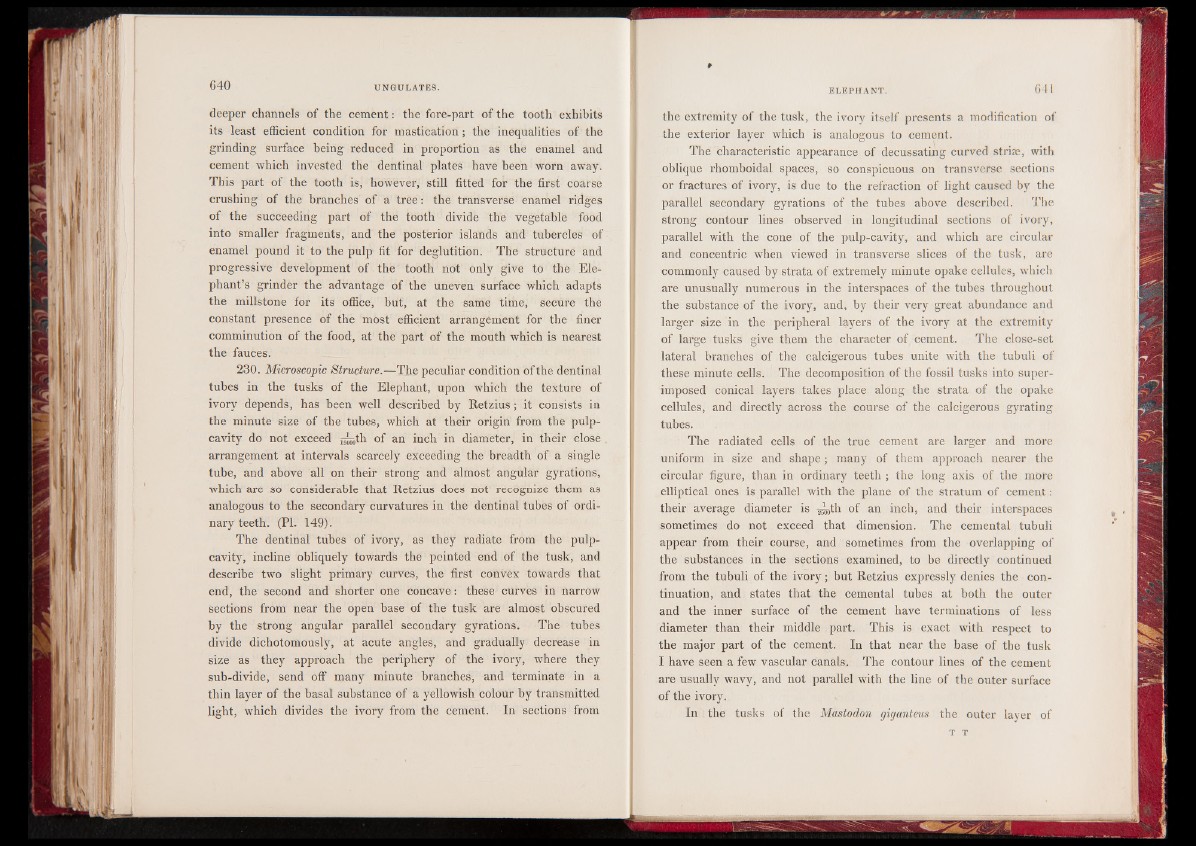
deeper channels of the cement: the fore-part of the tooth exhibits
its least efficient condition for mastication; the inequalities of the
grinding surface being reduced in proportion as the enamel and
cement which invested the dentinal plates have been worn away.
This part of the tooth is, however, still fitted for the first coarse
crushing of the branches of a tree: the transverse enamel ridges
of the succeeding part of the tooth divide the vegetable food
into smaller fragments, and the posterior islands and tubercles of
enamel pound it to the pulp fit for deglutition. The structure and
progressive development of the tooth not only give to the Elephant’s
grinder the advantage of the uneven surface which adapts
the millstone for its office, but, at the same time, secure the
constant presence of the most efficient arrangement for the finer
comminution of the food, at the part of the mouth which is nearest
the fauces.
230. Microscopic Structure.—The peculiar condition of the dentinal
tubes in the tusks of the Elephant, upon which the texture of
ivory depends, has been well described by Retzius; it consists in
the minute size of the tubes, which at their origin from the pulp-
cavity do not exceed 15500th of an inch in diameter,- in their close
arrangement at intervals scarcely exceeding the breadth of a single
tube, and above all on their strong and almost angular gyrations,
which are so considerable that Retzius does not recognize them as
analogous to the secondary curvatures in the dentinal tubes of ordinary
teeth. (PI. 149).
The dentinal tubes of ivory, as they radiate from the pulp-
cavity, incline obliquely towards the pointed end of the tusk, and
describe two slight primary curves, the first convex towards that
end, the second and shorter one concave: these curves in narrow
sections from near the open base of the tusk are almost obscured
by the strong angular parallel secondary gyrations. The tubes
divide dichotomously, at acute angles, and gradually decrease in
size as they approach the periphery of the ivory, where they
sub-divide, send off many minute branches, and terminate in a
thin layer of the basal substance of a yellowish colour by transmitted
light, which divides the ivory from the cement. In sections from
the extremity of the tusk, the ivory itself presents a modification of
the exterior layer which is analogous to cement.
The characteristic appearance of decussating curved striae, with
oblique rhomboidal spaces, so conspicuous on transverse sections
or fractures of ivory, is due to the refraction of light caused by the
parallel secondary gyrations of the tubes above described. The
strong contour lines observed in longitudinal sections of ivory,
parallel with the cone of the pulp-cavity, and which are circular
and concentric when viewed in transverse slices of the tusk, are
commonly caused by strata of extremely minute opake cellules, which
are unusually numerous in the interspaces of the tubes throughout
the substance of the ivory, and, by their very great abundance and
larger size in the peripheral layers of the ivory at the extremity
of large tusks give them the character of cement. The close-set
lateral branches of the calcigerous tubes unite with the tubuli of
these minute cells. The decomposition of the fossil tusks into superimposed
conical layers takes place along the strata of the opake
cellules, and directly across the course of the calcigerous gyrating
tubes.T
he radiated cells of the true cement are larger and more
uniform in size and shape; many of them approach nearer the
circular figure, than in ordinary teeth ; the long axis of the more
elliptical ones is parallel with the plane of the stratum of cement:
their average diameter is ^ th of an inch, and their interspaces
sometimes do not exceed that dimension. The cemental tubuli
appear from their course, and sometimes from the overlapping of
the substances in the sections examined, to be directly continued
from the tubuli of the ivory; but Retzius expressly denies the continuation,
and states that the cemental tubes at both the outer
and the inner surface of the cement have terminations of less
diameter than their middle part. This is exact with respect to
the major part of the cement. In that near the base of the tusk
I have seen a few vascular canals. The contour lines of the cement
are usually wavy, and not parallel with the line of the outer surface
of the ivory.
In the tusks of the Mastodon giganteus the outer layer of
T T